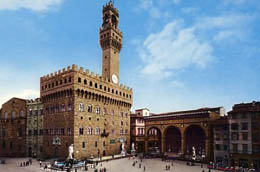
Italian scientists are searching in Florence for the famous da Vinci fresco
 |
The wall was located last summer in the so-called 16th-century Salon of the palace, and this discovery has immediately revived hopes that the famous fresco, already considered the pinnacle of art in its time, might actually exist. Now, new findings will be assessed by an expert committee, and in addition to a thorough review of specific archival documents, sondages will also take place in the wall.
However, the hope for the rediscovery of Leonardo's work is accompanied by the usual conflicting opinions.
While the discoverer of the "secret" wall, Maurizio Seracini, is convinced that "significant" parts of the fresco could be uncovered behind this wall, the director of the cultural department of the city hall, Antonio Paolucci, believes that there is "little, or rather nothing," behind it.
Seracini is also supported by the world-renowned Leonardo specialist Carlo Pedretti, who suggests that records from Renaissance authors indicate that "the fresco can only be behind this wall." "I completely believe that," he declares.
Pedretti also rejects the hypothesis that another artist, Giorgio Vasari, could have covered Leonardo's fresco when asked to do so.
Vasari indeed received a similar commission concerning the covering of works by two other artists, Giotto and Masaccio, in two Florentine churches. However, modern examinations have shown that both frescoes remained intact under his intervention.
"Vasari did not destroy these two works; why would he do it to Leonardo's fresco?" Pedretti questions.
The former Minister of Culture, Paolucci, does not fully share such optimism regarding the potential rediscovery of Leonardo's work. Nevertheless, he does not reject the formation of an international commission to assist in the search for the truth about what really happened to Leonardo's fresco.
For generations, researchers believed that the work succumbed to the ravages of time. Simply because the artist approached its execution unorthodoxly and dismissed the traditional method of fresco painting, which involved painting on a layer of wet plaster, and applied oil paints directly on a dry surface. The painting soon started to chip away, and the artist allegedly gave up and went to Milan.
Although awareness of this monumental fresco has faded into the background, its creation is documented, and it is known that the first strokes of the brush were made by Leonardo with a host of admirers on June 6, 1505.
Leonardo da Vinci (1452 to 1519) was the universal genius of the Renaissance - painter, sculptor, architect, musician, poet, and scientist. He was born in the Tuscan town of Vinci, worked in Florence, Milan, and also lived a long time in France. His contemporaries considered the missing fresco in the Old Palace to be his crowning work.
The Battle of Anghiari was neither extraordinarily large nor extraordinarily bloody; so why did Leonardo choose this subject? Simply because this battle secured Florence's dominance over the whole of Tuscany, which the Duke of Milan, Visconti, attempted to acquire but lost. As Machiavelli writes about it, the Milanese did not lose power, but Florence gained a lot.
The English translation is powered by AI tool. Switch to Czech to view the original text source.
0 comments
add comment









